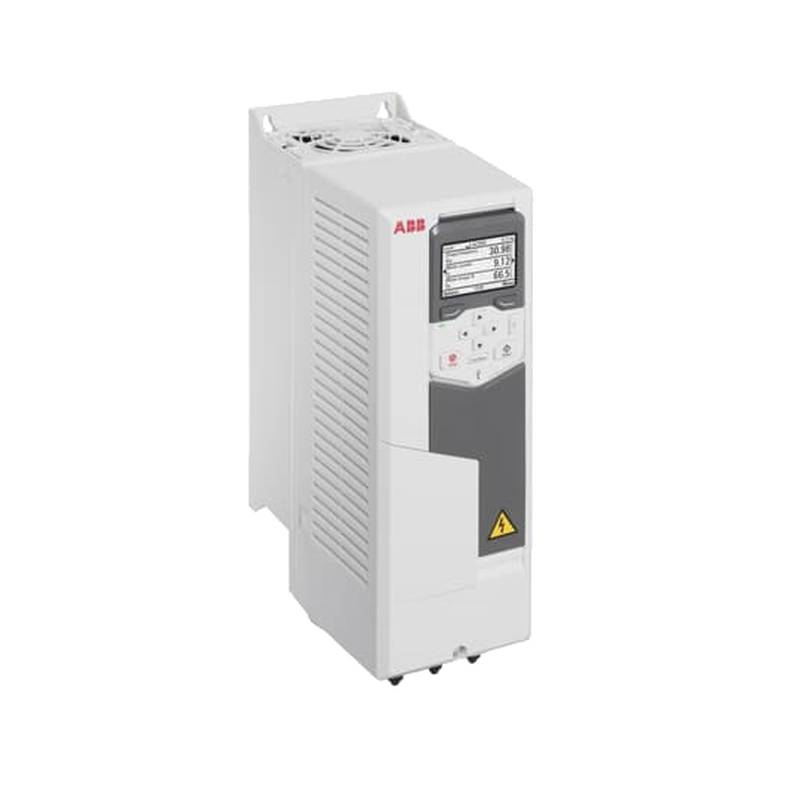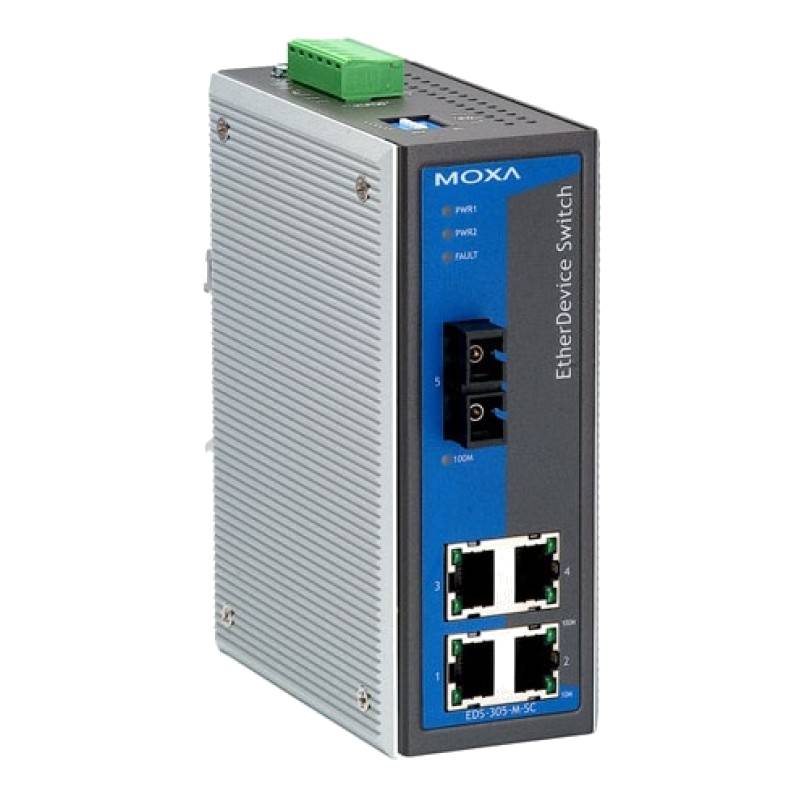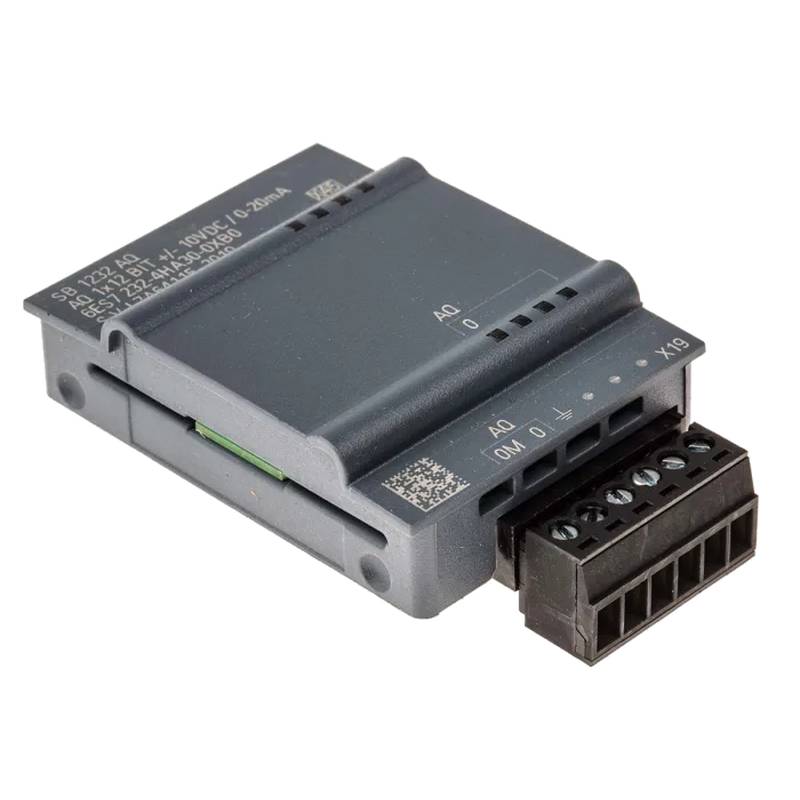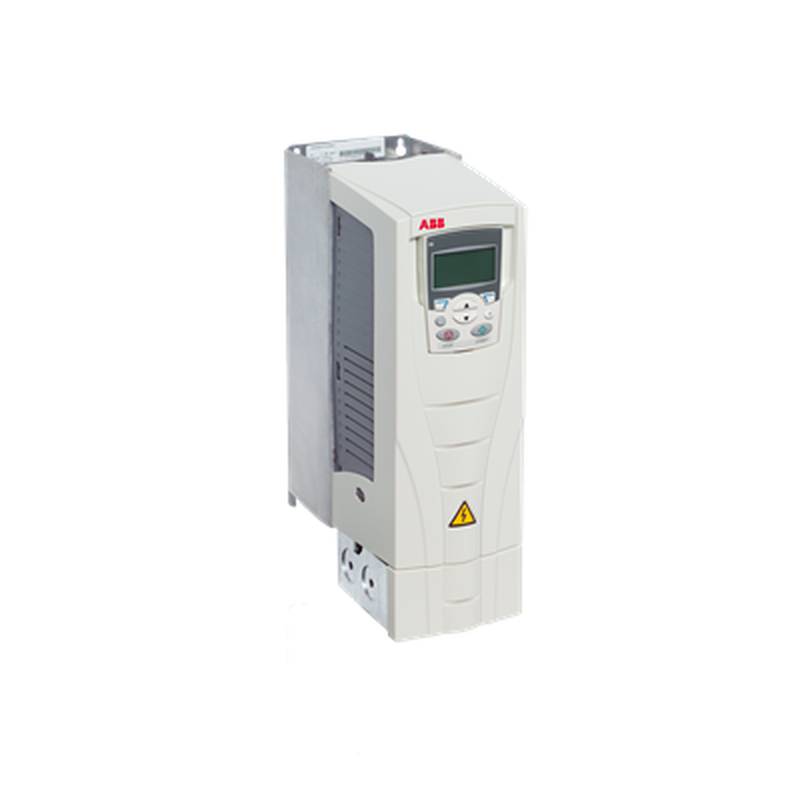
The ABB ACS580-01-12A7-4 Variable Frequency Drive (VFD) is a robust and versatile power conversion solution engineered for demanding industrial applications. It delivers precise motor control, enhanced energy efficiency, and simplified operation, making it a compelling choice for various sectors. Key advantages include its compact design, intuitive user interface, and built-in safety features. Core technical parameters highlight its power handling capabilities, with a 4 kW (5.5 HP) rating, and a 12.7 Amp current capacity, operating on a 380-480V three-phase power supply. The drive's ability to provide a consistent and reliable output voltage and frequency makes it ideal for optimizing motor performance across diverse loads.
Product Specifications
| Parameter | Value |
| :------------------------- | :-------------------------------------- |
| Model Number | ACS580-01-12A7-4 |
| Rated Power (kW) | 4 |
| Rated Power (HP) | 5.5 |
| Rated Current (A) | 12.7 |
| Input Voltage (3-Phase) | 380-480 V |
| Output Voltage (3-Phase) | 0-100% of input voltage |
| Output Frequency | 0-500 Hz |
| Protection Class | IP21 (UL Type 1) |
| Dimensions (H x W x D) mm | 247 x 144 x 187 |
| Weight (kg) | 5.2 |
| Ambient Temperature Range | -25 °C to +50 °C |
Core Features & Market Positioning
The ABB ACS580-01-12A7-4 distinguishes itself through its all-compatible design, offering seamless integration with a wide array of motors, including asynchronous and permanent magnet motors. This adaptability simplifies selection and installation for users. Its intuitive FlashDrop tool enables rapid parameter setting without powering up the drive, significantly reducing commissioning time. Furthermore, the drive incorporates advanced features like built-in braking choppers and robust overload protection, enhancing system reliability and reducing the need for external components. Positioned as a highly efficient and user-friendly solution, the ACS580 series, and specifically the ACS580-01-12A7-4, competes effectively in markets demanding flexibility, ease of use, and dependable performance.
Key Application Scenarios
This VFD finds extensive application in sectors requiring precise motor speed and torque control. It is commonly employed in pump and fan applications, where variable speed drives optimize energy consumption by matching motor output to system demand, thereby reducing operational costs. Conveyor systems in material handling, mixers in food and beverage processing, and extruders in plastics manufacturing are other prominent use cases. Its robust construction and IP21 protection rating also make it suitable for environments with moderate dust and moisture. The ACS580-01-12A7-4 is engineered to enhance productivity and efficiency in a wide range of variable torque and constant torque applications across manufacturing, water treatment, and building automation industries.
Practical System Integration Guidance
Integrating the ABB ACS580-01-12A7-4 into an industrial system is streamlined by its user-friendly design. The drive supports multiple communication protocols, allowing for flexible integration into existing control systems and SCADA networks. For installation, ensure adequate ventilation as the drive generates heat, especially under heavy load. Wiring should adhere strictly to the provided manual, paying close attention to grounding and phase connections to prevent damage and ensure safety. Commissioning can be greatly expedited using the FlashDrop tool for basic parameter configuration, or through the intuitive onboard control panel. For advanced control strategies or integration with specific fieldbuses, consult the comprehensive programming manual to map parameters and configure I/O for optimal system performance.
Operation and Risk Mitigation
Safe and efficient operation of the ABB ACS580-01-12A7-4 VFD is paramount. Always ensure the drive is correctly grounded and that all power and motor connections are secure before energizing the unit. Familiarize yourself with the common fault codes displayed on the drive's interface; for instance, "Overcurrent" faults typically indicate a motor or load issue, while "Overvoltage" or "Undervoltage" may point to power supply instability. Implementing proper lockout/tagout procedures during maintenance is critical to prevent unexpected startup. Regular inspection of ventilation paths to prevent dust accumulation will also mitigate overheating risks and ensure the longevity of the drive.
Scalability & Long-Term Value
The ABB ACS580-01-12A7-4 offers excellent scalability and long-term value through its compatibility with ABB's broader automation ecosystem. It can be readily integrated with ABB Ability™ solutions for enhanced monitoring, diagnostics, and predictive maintenance, facilitating the transition to Industrial Internet of Things (IIoT) environments. The drive's modular design allows for the addition of optional communication modules and I/O extensions, enabling system upgrades and adaptation to evolving process requirements without requiring a complete drive replacement. This future-proofing capability, combined with the drive's inherent energy-saving potential and robust construction, ensures a significant return on investment over its operational lifespan.
Frequently Asked Questions
What are the main benefits of using the ABB ACS580-01-12A7-4?
This VFD offers superior energy efficiency by precisely controlling motor speed, leading to reduced power consumption. Its user-friendly interface and FlashDrop tool drastically cut down commissioning time for engineers. The drive's robust design and built-in protection features enhance system reliability and operational safety.
The ACS580-01-12A7-4 provides flexible motor control for various motor types, including asynchronous and permanent magnet motors. It minimizes mechanical stress on driven equipment through smooth acceleration and deceleration profiles. This leads to extended equipment lifespan and reduced maintenance needs across applications.
It supports numerous communication protocols for seamless integration into existing automation systems and networks. The compact footprint saves valuable panel space in installations with limited room. Its all-compatible nature ensures broad applicability across diverse industrial sectors.
How do I wire the ABB ACS580-01-12A7-4 for a three-phase motor?
Connect the incoming three-phase power supply to terminals L1, L2, and L3 on the drive. Ensure the power supply voltage is within the specified 380-480V range for optimal performance. Verify proper grounding of both the drive and the motor for electrical safety.
Connect the motor leads to terminals T1, T2, and T3. For motors with separate ground wires, ensure they are also securely connected to the grounding terminal on the drive or enclosure. Always refer to the motor nameplate and the drive's wiring diagram for correct connection sequences.
For safety, ensure all power is disconnected before commencing any wiring. Double-check all connections for tightness and correctness before applying power to the drive. Incorrect wiring can lead to drive damage or hazardous conditions.
What are common fault codes for the ACS580-01-12A7-4 and how to address them?
An "Overcurrent" fault (e.g., F001) usually means the motor is drawing too much current. Check for mechanical binding in the driven equipment, verify motor nameplate current against drive settings, and ensure the motor is not overloaded. Reduce acceleration ramps if too steep.
An "Overvoltage" fault (e.g., F002) can occur if the input voltage is too high or during regenerative braking. Check the input power supply stability. If regenerative braking is the cause, consider installing an external braking resistor or adjust braking ramp settings.
An "Undervoltage" fault (e.g., F003) typically indicates an unstable or low input power supply. Verify the incoming voltage is within the drive's operating range (380-480V). Ensure all power connections are secure and that the power source can adequately support the drive's demand.
Can the ABB ACS580-01-12A7-4 be used with single-phase motors?
The standard configuration of the ACS580-01-12A7-4 is designed for three-phase motor operation. It is not intended for direct connection or control of standard single-phase motors. Using it with single-phase motors would likely result in damage to the drive or motor.
For applications requiring variable speed control of single-phase motors, specific VFD models designed for single-phase output or phase converters are necessary. Always ensure the VFD is rated for the specific motor type and power supply phase configuration. Consult ABB documentation or a qualified technician if unsure.
If a single-phase motor must be used in an application where a three-phase VFD is present, a phase converter would be needed to generate a three-phase output from the single-phase input. This adds complexity and cost to the system.
What is the maximum ambient temperature for operating the ACS580-01-12A7-4?
The ABB ACS580-01-12A7-4 can operate within an ambient temperature range of -25 °C to +50 °C. Operating outside this range can lead to reduced performance, potential damage, or failure of the drive components. Proper ventilation is crucial, especially at higher temperatures.
At the upper end of the temperature range (+50 °C), the drive's output current capability may be de-rated to prevent overheating. It is essential to consult the drive's manual for specific de-rating curves and guidelines to ensure reliable operation under such conditions.
Ensure the installation environment provides adequate airflow around the drive. Avoid placing it in direct sunlight, near heat sources, or in enclosed spaces without proper cooling. Consider using external fans or enhanced ventilation if operating consistently near the maximum temperature.
How can I program basic parameters on the ACS580-01-12A7-4 using the keypad?
Navigate the menu structure using the arrow keys and the Enter button. Common parameters like Start/Stop source, speed reference, and motor data (nominal current, frequency) are easily accessible. The intuitive layout guides you through most essential settings.
The onboard keypad allows for direct input of numerical values and selection from predefined options. Parameter groups are organized logically, making it straightforward to locate and adjust settings for motor control and I/O configuration. Save changes by exiting the parameter menu.
For initial setup, focus on motor data entry to ensure optimal performance and protection. The keypad is ideal for quick adjustments or on-site troubleshooting when more advanced programming tools are not available. Always confirm parameter values are correctly entered before running the motor.
What is the IP rating of the ABB ACS580-01-12A7-4 and what does it signify?
The ABB ACS580-01-12A7-4 has an IP21 rating, which corresponds to UL Type 1 for enclosures. This signifies protection against solid foreign objects greater than 12.5 mm in diameter (like a finger) and against vertically falling water drops.
An IP21 rating indicates that the drive is protected against dripping water when tilted up to 15 degrees from its normal upright position. This level of protection is suitable for clean, dry indoor environments where there is minimal risk of direct water spray or heavy dust accumulation.
While IP21 offers basic protection, it is not suitable for outdoor use or environments with high levels of moisture, dust, or corrosive substances. For such conditions, enclosures with higher IP ratings (e.g., IP54, IP65) or specific mounting kits would be required.
How does the FlashDrop tool simplify the commissioning of the ACS580-01-12A7-4?
The FlashDrop tool allows engineers to program and copy parameter settings to the VFD without needing to power it up. This significantly accelerates the commissioning process, especially when deploying multiple drives with identical configurations. It eliminates the need for manual keypad entry for each drive.
Engineers can create parameter sets offline on a PC using FlashDrop software and then quickly upload these settings to the drive. This reduces on-site time, minimizes potential for human error during manual programming, and ensures consistency across installations. It's particularly useful for large projects.
This tool supports backup and restore functions for drive parameters, aiding in quick replacement if a drive fails. Its ease of use and ability to configure drives before installation contribute to faster project timelines and reduced labor costs associated with setup.
What are the communication options available for the ACS580-01-12A7-4?
The ACS580-01-12A7-4 supports various fieldbus protocols through optional communication modules. Common options include PROFIBUS DP, PROFINET, EtherNet/IP, and Modbus TCP/IP, enabling seamless integration into industrial automation networks. Standard Modbus RTU is also supported via RS-485.
These communication options allow for remote monitoring, control, and diagnostics of the VFD from a central control system like a PLC or SCADA. Parameters can be adjusted, status information retrieved, and fault codes read remotely, enhancing operational visibility and efficiency.
Selecting the appropriate communication module depends on the existing network infrastructure and control system requirements. This flexibility ensures the ACS580-01-12A7-4 can be incorporated into diverse automation architectures, from simple to highly complex.
Does the ACS580-01-12A7-4 offer built-in safety functions?
Yes, the ACS580-01-12A7-4 includes built-in Safe Torque Off (STO) functionality as a standard feature. This safety function prevents the drive from unintentionally starting, ensuring a safe state during maintenance or emergency situations. It meets relevant safety integrity levels (SIL).
The STO function effectively disconnects the motor from the drive's power output, preventing torque generation. This is a crucial safety measure that can reduce the need for external mechanical braking systems in some applications, simplifying system design and reducing costs.
Proper implementation and integration of STO with the machine's overall safety system are essential. It requires careful consideration of wiring, safety control logic, and compliance with applicable safety standards to ensure the highest level of operational safety.

























